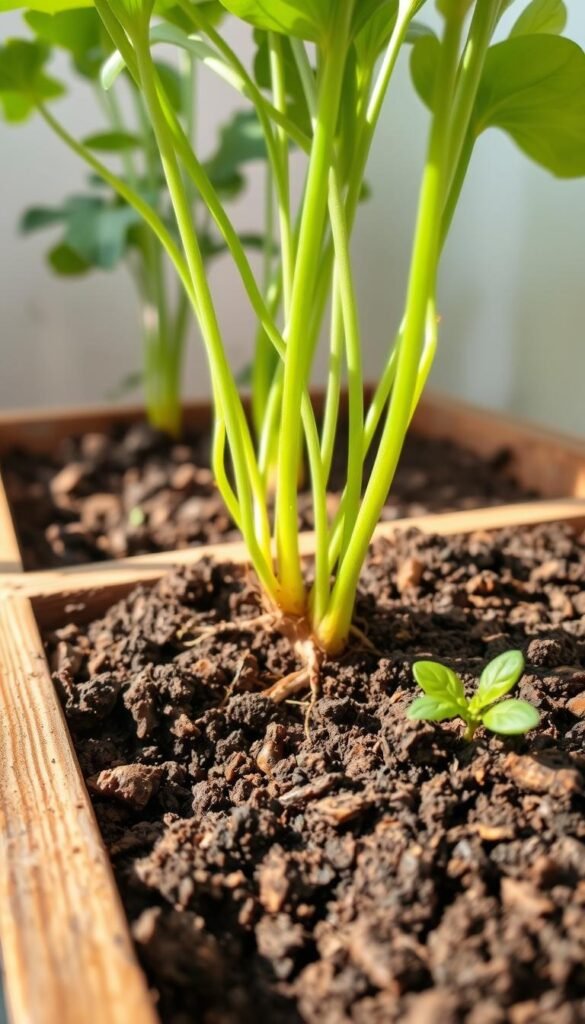Growing vibrant greenery in limited spaces starts with one secret: your potting mix matters more than you think. Whether you’re nurturing herbs on a windowsill or curating a balcony jungle, the right blend keeps roots happy and plants thriving. Unlike regular dirt, quality potting soil is engineered to stay light and drain quickly—critical for avoiding soggy containers.
Many urban growers don’t realize they can refresh last season’s mix instead of buying new bags. Take inspiration from seasoned gardeners who revived tired bulb pots by adding coconut coir and compost. This approach saves money and reduces waste, aligning perfectly with eco-friendly container gardening practices.
Healthy roots need both nutrients and airflow. A balanced blend might include 60% reused potting soil boosted with perlite for drainage. Even small upgrades, like mixing in worm castings, can transform lackluster growth into lush foliage.
In this guide, you’ll discover how to evaluate your current mix, spot nutrient deficiencies, and create custom blends for specific plants. We’ll also explore simple ways to repurpose materials you already own. Ready to turn that lifeless dirt into a powerhouse for your green companions? Let’s dig deeper.
Getting to Know Your Potting Soil
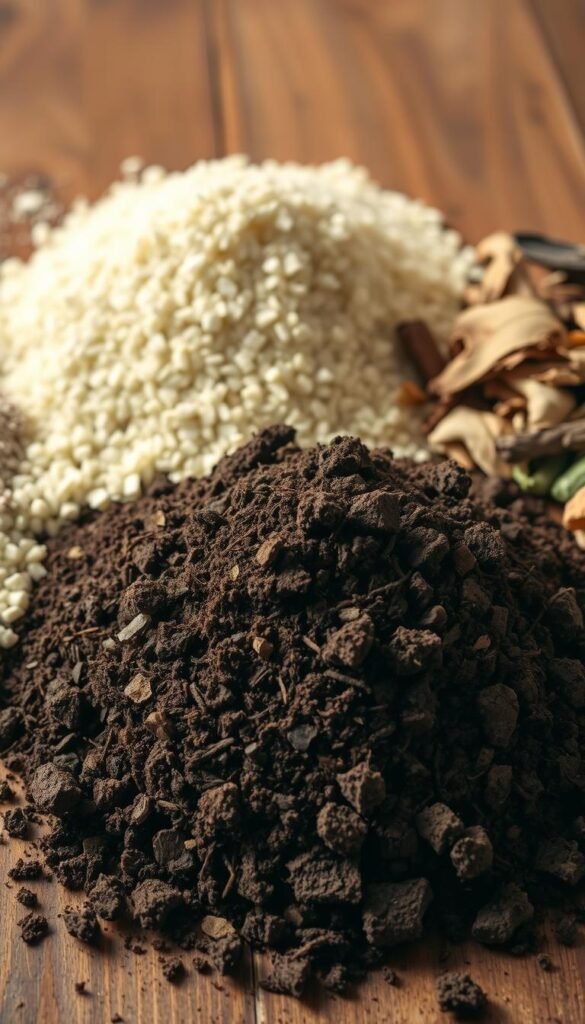
Urban plant success begins with understanding what’s in your pots. Unlike backyard dirt, potting mixes are designed for confined spaces where roots need room to breathe. Think of them as custom-engineered environments—lightweight, fluffy, and packed with ingredients that mimic ideal growing conditions.
What Is Potting Soil and Why It Matters?
Potting soil isn’t just dirt—it’s a carefully balanced blend. Natural garden soil becomes dense in containers, suffocating roots. Quality mixes use materials like peat moss to retain moisture without waterlogging. Perlite, those tiny white pebbles, creates air pockets for oxygen flow. This combo prevents compaction, letting roots spread freely.
Understanding Key Ingredients for Container Gardening
Three heroes make container mixes work: peat moss, perlite, and rice hulls. Peat holds water like a sponge, releasing it slowly. Perlite keeps the blend loose, while rice hulls break down over time, feeding microbes. Together, they create a habitat where beneficial bacteria thrive, recycling nutrients for plants.
Knowing your mix’s composition helps decide when to refresh it. For example, spent soil from last season’s tomatoes can regain life with new organic matter. Learn how to reuse potting soil effectively by spotting when it needs a nutrient boost or better drainage.
Recognizing When Not to Reuse Your Old Soil
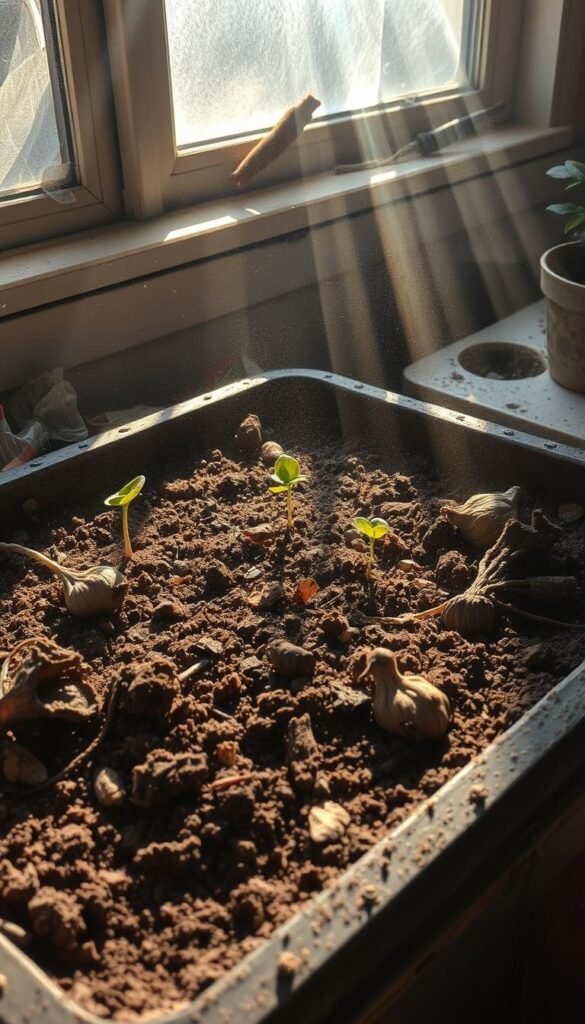
Not all soil deserves a second chance—learn the red flags. Your container plants depend on a healthy foundation, and ignoring warning signs could spread problems to new growth. Start by assessing texture: if water pools on the surface or takes minutes to drain, compaction has likely choked oxygen flow.
Spotting Hidden Threats in Used Mixes
Crumbly soil turning dense like clay signals trouble. Squeeze a handful—if it stays clumped, roots won’t breathe. A sour or musty odor? That’s microbial imbalance, often from decomposed organic matter. These conditions starve plants of nutrients even after amendments.
Watch for tiny insects darting when you water. Fungus gnats resemble fruit flies, while white webs hint at mold. If previous plants had yellow leaves or stunted growth, pathogens might linger. Reusing contaminated mix risks infecting new seedlings.
Solarization offers a fix for mildly affected soil: bag it, moisten slightly, and leave in direct sun for 4-6 weeks. Heat kills most pests and spores. However, soil from diseased tomatoes or peppers often needs complete replacement—better safe than sorry.
Trust your senses. Gritty, foul-smelling blends rarely recover. When in doubt, refresh with 50% new potting mix. Your plants will thank you with vigorous growth.
Enhancing Old Potting Soil with Nutrient-Rich Amendments
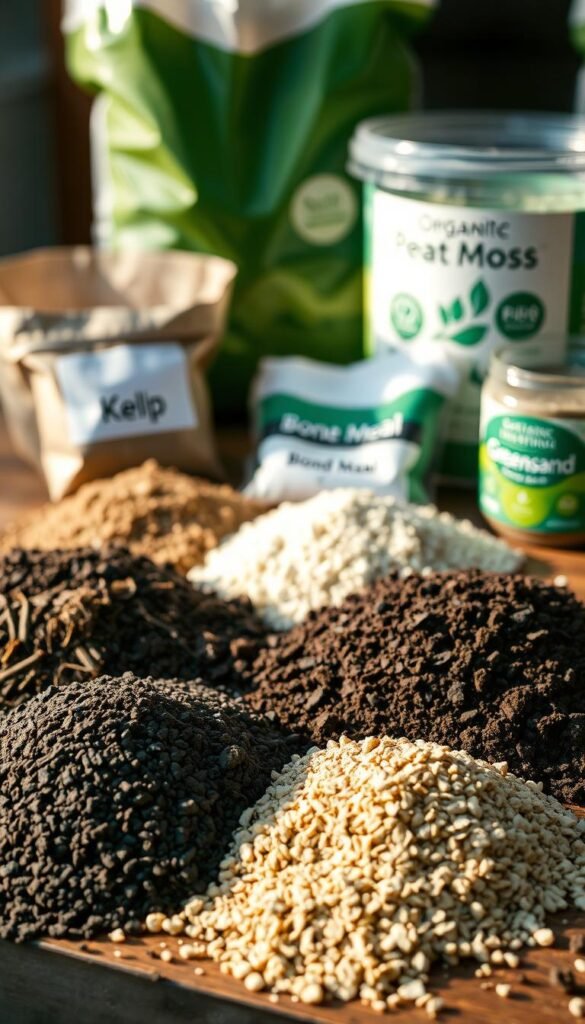
Breathing new life into your container plants starts beneath the surface. Worn-out mixes regain vigor when paired with nature’s recyclers—organic materials that feed roots and fuel growth. Let’s explore how simple additives can transform tired blends into thriving ecosystems.
The Role of Compost, Manure, and Organic Fertilizers
Compost acts like a multivitamin for depleted mixes. Mix one part finished compost with three parts old potting soil to replenish organic matter. Well-aged manure works similarly, releasing nitrogen slowly without burning delicate roots.
Organic fertilizers like bone meal or fish emulsion offer targeted nutrition. Sprinkle a handful per gallon of mix before planting heavy feeders like tomatoes. These natural options feed microbes while preventing chemical buildup in containers.
Boosting Soil Life with Worm Castings and Beneficial Microbes
Worm castings are nature’s probiotic for potting mixes. Add ¼ cup per gallon to introduce enzymes and bacteria that break down nutrients. This creates a self-sustaining system where microorganisms continually feed your plants.
For extra microbial power, try compost tea. Steep a cheesecloth bag of compost in water overnight, then use it to moisten your refreshed mix. The liquid teems with beneficial organisms that colonize root zones.
Pro tip: Always blend amendments thoroughly. Use a tarp or large bin to mix components until the texture resembles crumbled chocolate cake. Test drainage by watering a small sample—if it flows freely within seconds, you’ve nailed the balance.
Techniques for Mixing and Rejuvenating Your Garden Soil
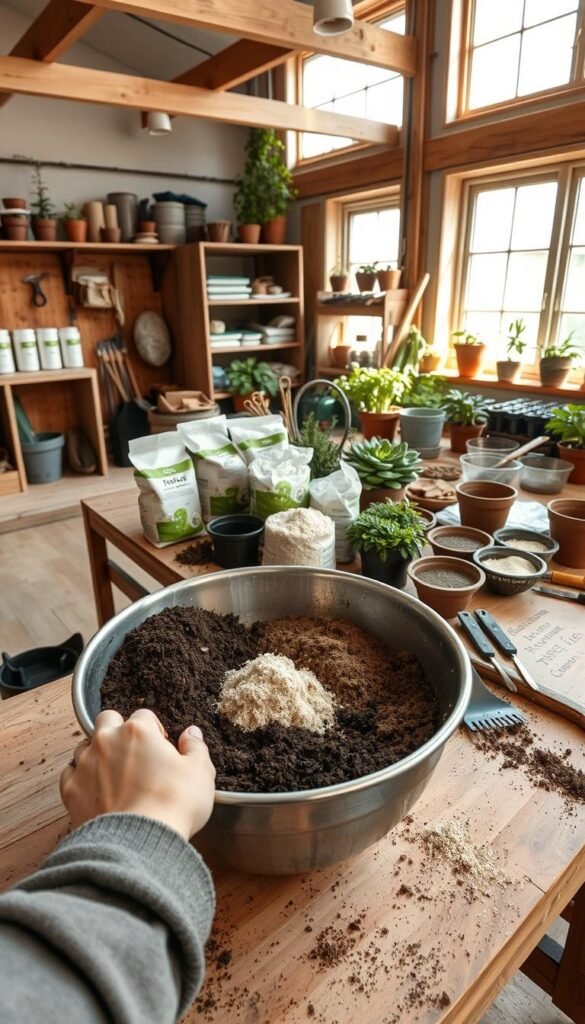
Reviving your plant’s foundation doesn’t require a complete overhaul—sometimes a simple touch-up works wonders. Let’s explore two approaches to breathe life back into your containers: quick fixes versus full renovations.
Top-Dressing Versus a Full Soil Refresh
Top-dressing means sprinkling fresh compost or organic fertilizer over existing soil. It’s perfect for large raised garden beds or established plants needing gentle boosts. Imagine refreshing basil by adding worm castings to the surface—roots absorb nutrients as you water.
A full refresh involves emptying pots entirely. Use this method when soil feels like concrete or smells sour. One gardener rescued compacted pepper pots by mixing old soil with coconut coir and perlite, restoring airflow overnight.
For top-dressing:
- Scrape off the top 1-2 inches of tired mix
- Replace with equal parts compost and fresh potting soil
- Water gently to activate nutrients
When refreshing completely:
- Dump soil onto a tarp, breaking clumps with hands
- Mix in 30% compost and 20% perlite for drainage
- Test moisture by squeezing—it should crumble, not stick
Always leave 1 inch space below the pot’s rim. This prevents overflow while watering and keeps roots from drowning. Remember: loose soil means happy plants!
Apartment Gardening Soil Tips: Mixing, Rejuvenating, and Reusing
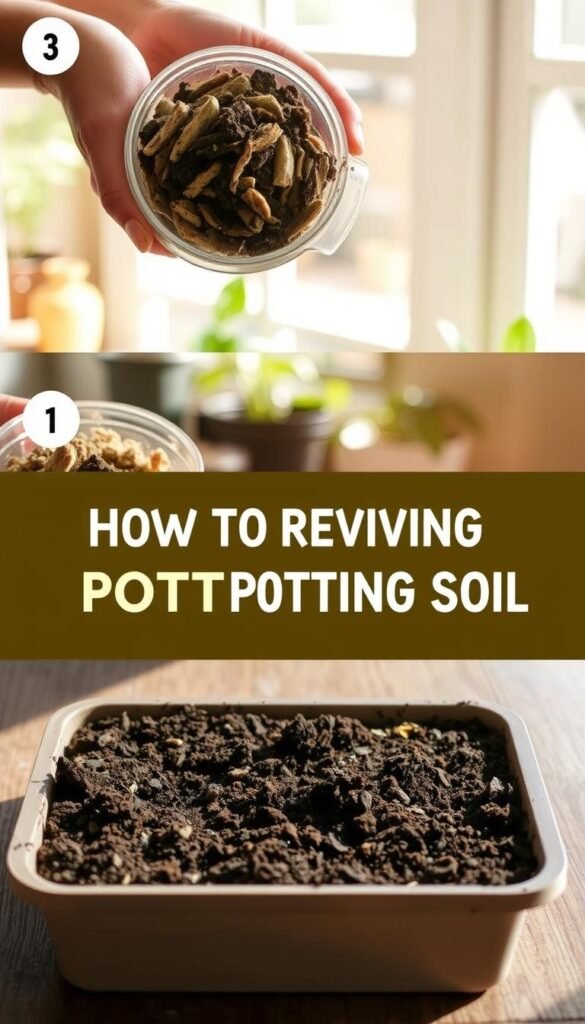
Transform tired potting mix into a vibrant plant paradise with simple upgrades. Revitalizing your growing medium saves money while giving roots the perfect environment to flourish. Let’s walk through the refresh process and learn how to keep containers thriving all season.
Your 5-Step Soil Revival Blueprint
- Clear the stage: Empty pots completely, shaking off loose material. Remove dead roots and crusty chunks—they block airflow.
- Amplify nutrition: Combine 2 parts old mix with 1 part compost. Add ½ cup worm castings per gallon for microbial magic.
- Boost drainage: Mix in perlite or coarse sand until the blend feels crumbly. Squeeze a handful—it should break apart easily.
- Test hydration: Moisten a small sample. Water should drain within 10 seconds. If it pools, add more perlite.
- Recharge regularly: Every 6-8 weeks, scratch 1 tablespoon organic fertilizer into the surface. Water deeply to activate nutrients.
Mastering Moisture Balance in Containers
Proper texture prevents root rot while keeping plants hydrated. Try these checks:
- Press your finger 2 inches deep—soil should feel cool but not wet
- Watch for water escaping drainage holes within 30 seconds of pouring
- If mix shrinks from pot edges, add peat moss to retain moisture
Notice faster growth after refreshing? That’s your success signal! For stubborn blends, replace 30% with fresh potting mix. Your green companions will reward you with lush leaves and vibrant blooms.
Innovative Methods for Reusing Soil in Container and Raised Beds
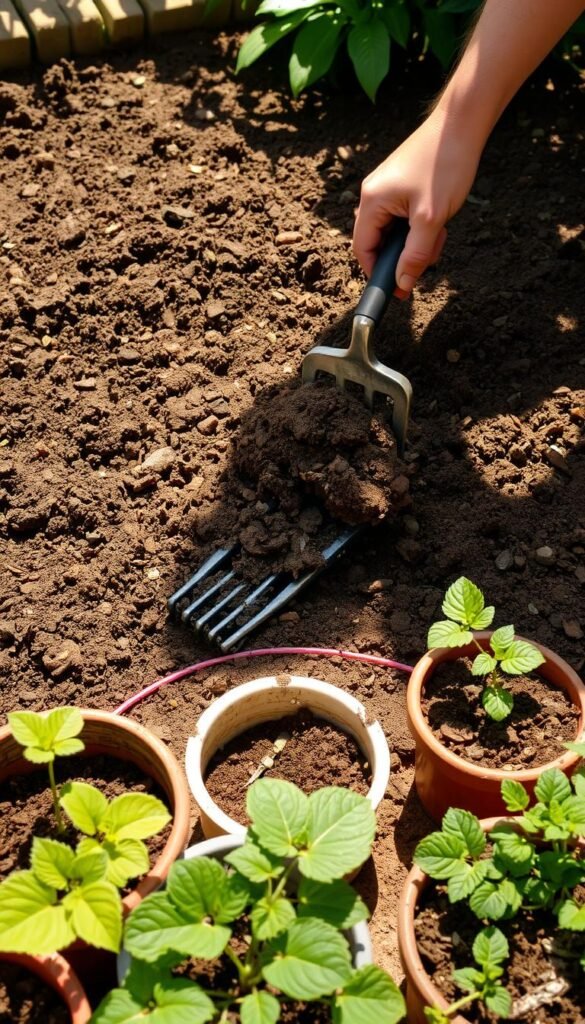
Unlock hidden potential in last season’s soil with clever repurposing strategies. Your containers and garden beds can become eco-friendly powerhouses by blending old and new materials—no waste required.
Breathing New Purpose Into Old Mixes
Turn tired potting soil into a raised bed superstar. Blend equal parts spent mix and fresh compost to create a fluffy foundation for vegetables. The existing microbes team up with new organic matter, creating a nutrient-rich environment. One gardener boosted her tomato yield by layering old soil with straw in raised garden beds—a double win for drainage and fertility.
For container gardening, use old soil as a base layer. Fill the bottom third of pots with recycled mix, then top with premium blend. This “lasagna method” saves money while maintaining proper moisture levels. Add perlite to the upper layer if roots need extra breathing room.
Try these creative combinations:
- Mix 40% old potting soil with 30% coconut coir and 30% worm castings
- Layer recycled soil between cardboard and mulch for no-dig flower beds
- Combine with sand and gravel to create custom succulent substrates
Always test your refreshed blend before planting. Squeeze a handful—properly amended soil crumbles like moist cake. If it clumps, add more aerating ingredients. Your plants get a familiar microbial community while you reduce landfill contributions. Win-win!
Balancing Nutrients and Microbial Health
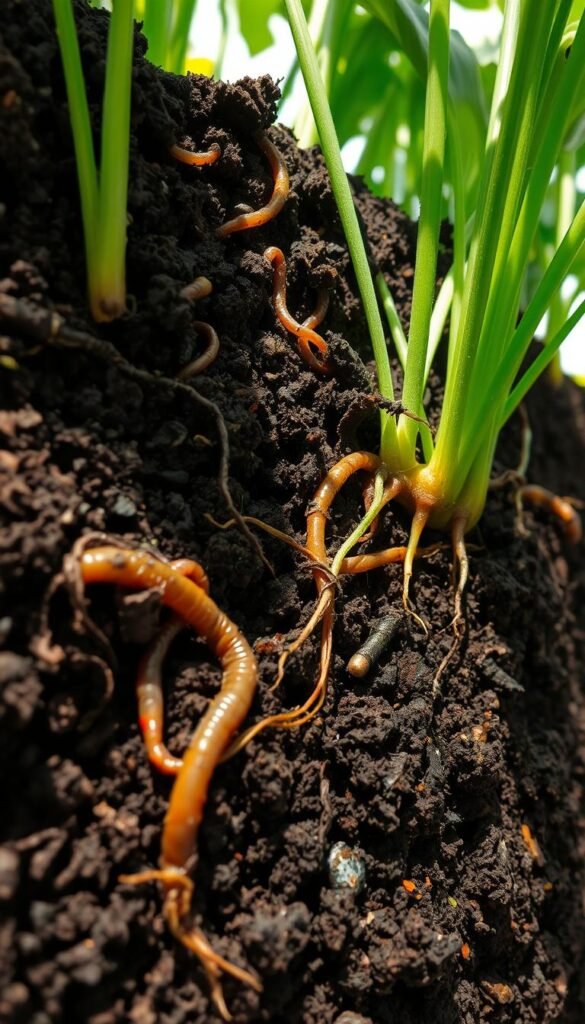
Your plants thrive when their underground world gets the right care. Healthy potting soil isn’t just about adding fertilizer—it’s about creating a living environment where roots and microbes work together. Think of it as a tiny ecosystem where every ingredient plays a role.
Feed the System, Not Just the Plant
Start by mixing 1 part compost into old potting soil each season. This replenishes organic matter and introduces fresh microbes. Worm castings are another powerhouse—sprinkle ½ cup per gallon to boost nitrogen and beneficial bacteria.
Organic fertilizers like fish emulsion work differently than synthetic options. They release nutrients slowly, feeding plants while improving soil structure. Test your mix every 6 months with a simple soil moisture meter to check both hydration and nutrient levels.
Microbes need air and water to thrive. Ensure containers drain within 10 seconds after watering—add perlite if they don’t. A balanced environment prevents diseases and helps roots grow deeper. When microbes flourish, they break down organic matter into plant-ready food naturally.
Keep your soil active year-round by rotating crops in containers. Leafy greens? Follow them with beans to naturally replenish nitrogen. This approach keeps the microbial community diverse and resilient, just like nature intended.
Finishing Touches for a Thriving Indoor Garden
Your indoor oasis thrives on attention to detail—especially in its foundation. Blend equal parts refreshed old potting soil and new mix to create a balanced medium. This combination preserves beneficial microbes while adding fresh nutrients your plants crave.
Before planting, sift through the blend with your fingers. Remove any debris or stubborn clumps. Check for unusual odors or visible pests—these signal it’s time to start fresh. Healthy soil should smell earthy and crumble easily.
Top pots with a 1-inch layer of premium potting mix. This acts like a nutrient-rich blanket, protecting roots and slowing moisture loss. Store leftover blends in sealed bags away from direct sunlight to maintain quality.
Establish a simple care routine: test moisture weekly using your fingertip, and feed every 6-8 weeks with organic fertilizer. Watch for leaves that perk up after watering—this confirms your environment supports strong root development.
With these final adjustments, your green companions will flourish season after season. Smart reuse potting practices paired with mindful care create lush, vibrant displays that make every urban space feel alive.

